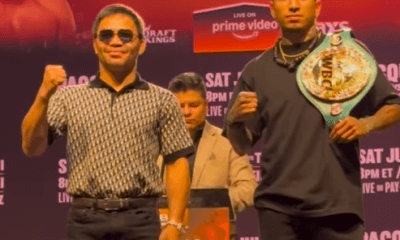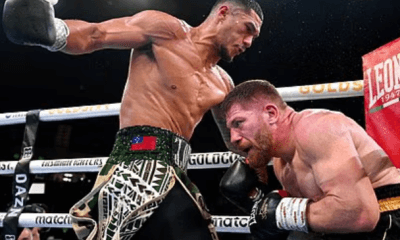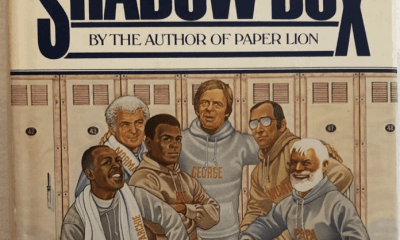Featured Articles
Why The Heck Is Floyd Mayweather Boxing’s Biggest Star?
It was recently announced by Forbes Magazine that Floyd Mayweather is the highest-paid athlete in the world. It was estimated that he’s grossed over 90 million dollars in the last year and didn’t earn one dollar via endorsements. Meaning he made 50 million dollars more than the top-rated golfer in the world, Tiger Woods, and 40 million dollars more than the single best player in the NBA, Lebron James.
Today Mayweather is by far the biggest star in professional boxing. Aside from perhaps Manny Pacquiao, Mayweather is the most relevant fighter in the sport, especially in the United States. It’s gotten to the point that a Mayweather tweet, regardless of whether or not it’s about his next fight or an NFL/NBA game that he bet, keeps the Internet riveted for days at a time. When he fights, ESPN, which doesn’t even cross promote the fights they air on ESPN2, cover the weigh-in for his fights and discuss his personality and career impact on many of their rehearsed good guy/bad guy debate programs.
When one thinks about how Mayweather has become such a huge personality, it’s nothing short of astonishing. Think about it, back in the summer of 2005, Mayweather had to take less money than his opponent, the late Arturo Gatti, just to be part of the main event on a pay per view card. So the question that must be answered is why has Floyd been able to transform himself into the most significant fighter in professional boxing considering……………
*Mayweather wasn’t a gold medal winner at the 1996 Olympics in Atlanta in which he participated in. Meaning that there wasn’t much ballyhoo surrounding his pro-debut like there was Muhammad Ali, Sugar Ray Leonard and Oscar De La Hoya. Actually, Mayweather’s teammate David Reid, the only American Gold medal winner during those games, garnered much more attention and hype than did Mayweather. Basically, Mayweather fought as a pro for nine years before most quasi boxing fans knew of him.
*Mayweather severely lacks the charm and charisma that superstars the likes of Muhammad Ali, Sugar Ray Leonard and Oscar De La Hoya had in abundance. Floyd isn’t interesting at all to watch or listen to during an interview. And he can’t converse during an interview regardless of the format without trying to convince the interviewer/audience of his greatness. He’s not particularly funny nor is he that insightful, at least that we’ve seen, unless he’s talking about his career. Ali and Leonard would be more entertaining watching an interview than Mayweather is participating in one.
*Mayweather has never been involved in terribly exciting fights. Part of that is due to his mastery of the ring and part of that is because he’s picked his spots when he finally met some of the better fighters he’s faced, especially since he’s campaigned above 135. For most fighters to be a draw, fans need to believe that regardless of the outcome they’re going to see something thrilling or exciting when they watch them fight.
*Mayweather’s style can really only be appreciated by sophisticated boxing observers. He’s not as fast or flashy as Muhammad Ali, Sugar Ray Leonard, Hector Camacho or Roy Jones were at their best. He’s more of a rich man’s Bernard Hopkins who takes what the opponent gives them and works off of that. Usually, only the real hard core fight fans enjoy watching a smooth technician work, fully aware that they’re probably not going to see a knockout or very memorable punches or exchanges the majority of the bout.
*Mayweather doesn’t destroy anybody. He doesn’t leave fighters splattered on the canvas the way the likes of a Bob Foster, Thomas Hearns or Roberto Duran did during his lightweight title reign. And that’s not a shot at him or his style because his style is one to behold if you know what you’re watching when viewing professional boxing at the highest level. However, the masses who buy Mayweather’s fights want to see knockouts and knockdowns, which cannot be taken for granted when Floyd fights. Yet, enough fringe boxing fans flock to see him when he fights?
Most of the time for a fighter to be the face of boxing, he must be an off the chart talent with charisma the likes of Muhammad Ali or Sugar Ray Leonard (or Roy Jones). Oscar De La Hoya was a huge draw but he was more of a media creation than he was a special fighter. Mayweather may be a little more cerebral than Ali and Leonard, but he wasn’t as skilled, fast or flashy. And unlike Ali and Leonard, Floyd has the perception of avoiding the fighter who at one time was viewed at having the best chance to beat him in Manny Pacquiao. Which is a shame because there has never been a night during the years they’ve been pros that Mayweather wouldn’t have conclusively defeated Pacquiao.
Mike Tyson was the face of boxing during most of his prime. Granted, Tyson’s victories weren’t against opposition that resembled murderers row, but he did get rid of all the B-level fighters he faced in an impressive fashion. Tyson was a draw because he could be hyped and promoted as a genuine life-taker, and his knockout record, despite the opposition, backed it up. So it’s easy to see why quasi boxing fans flocked to watch Mike Tyson. They didn’t care that he wasn’t facing Ali, George Foreman, Joe Frazier or a prime Larry Holmes, they just wanted to see him knock someone out.In contrast, as already established, most of Floyd’s fights don’t end memorably.
When you examine Mayweather’s career, there isn’t that one fight in which you’ll think about where you were 10 years from now when you watched it compared to some of the greats listed above. We’ve seen better boxers than Mayweather, faster and flashier fighters, bigger punchers and greater warriors than Floyd, yet his next fight against an unproven Saul Alvarez this coming September will dominate the boxing world the weeks prior to the fight.
I’m astonished that a fighter who isn’t among the top three boxers, talents, speedsters, punchers, warriors or charismatic personalities of the last 40 years who is known for safely managing his career, is clearly the standard bearer of professional boxing. And with his top five future opponents last names’ being Khan, Alexander, Garcia, Ortiz and Alvarez, that’s not likely to change.
One must conclude that Mayweather realized around 2005 that he wasn’t the kid next door and was best suited to be promoted as the bad guy, despite the fact that he’s more closer to being a decent guy who is insecure about his standing and legacy historically. Floyd learned the business of selling and hyping not just himself but his fights and what him partaking in them should mean to all viewers and fans. Add to that his pristine record of 44-0 (26), fans who root against him have a reason to watch him fight, hoping that they’ll see it live if he ever loses. In the mean time he’s laughing all the way to the dealership to buy his next Rolls Royce, Bentley and Lamborghini.
Mayweather wouldn’t be the face of boxing today if there was an Ali, Leonard, De La Hoya or Tyson around, but they’re long gone. Give him credit for being able to make a safety first counter-puncher who avoided the only fight fans wanted him to deliver, to become the face of what once was the greatest sport in the world. And to Mayweather’s credit, due to what he’s had to work with, he couldn’t have played it any better inside or outside of the ring.
Mayweather didn’t make one dime on endorsements in the last fiscal year, something which is unheard of for someone of that notoriety, which basically says most agree with what’s been said above. Mayweather’s not getting endorsements means that nobody actually cares about him, which makes his PPV numbers even more astounding.
Floyd Mayweather, although he really shouldn’t be, compared to past fighters who were the most important fighters in boxing, is the most important fighter/boxer in 2013. That is totally befuddling if you examine everything surrounding him in totality.
{youtube}ZHIhsLhQ-q8{/youtube}
-

 Featured Articles3 weeks ago
Featured Articles3 weeks agoAvila Perspective, Chap. 330: Matchroom in New York plus the Latest on Canelo-Crawford
-

 Featured Articles2 weeks ago
Featured Articles2 weeks agoVito Mielnicki Jr Whitewashes Kamil Gardzielik Before the Home Folks in Newark
-

 Featured Articles4 weeks ago
Featured Articles4 weeks agoAvila Perspective, Chap 329: Pacquiao is Back, Fabio in England and More
-

 Featured Articles4 weeks ago
Featured Articles4 weeks agoOpetaia and Nakatani Crush Overmatched Foes, Capping Off a Wild Boxing Weekend
-

 Featured Articles3 weeks ago
Featured Articles3 weeks agoCatching Up with Clay Moyle Who Talks About His Massive Collection of Boxing Books
-

 Featured Articles4 weeks ago
Featured Articles4 weeks agoFabio Wardley Comes from Behind to KO Justis Huni
-

 Featured Articles1 week ago
Featured Articles1 week agoMore Medals for Hawaii’s Patricio Family at the USA Boxing Summer Festival
-

 Featured Articles4 weeks ago
Featured Articles4 weeks agoDelving into ‘Hoopla’ with Notes on Books by George Plimpton and Joyce Carol Oates
















